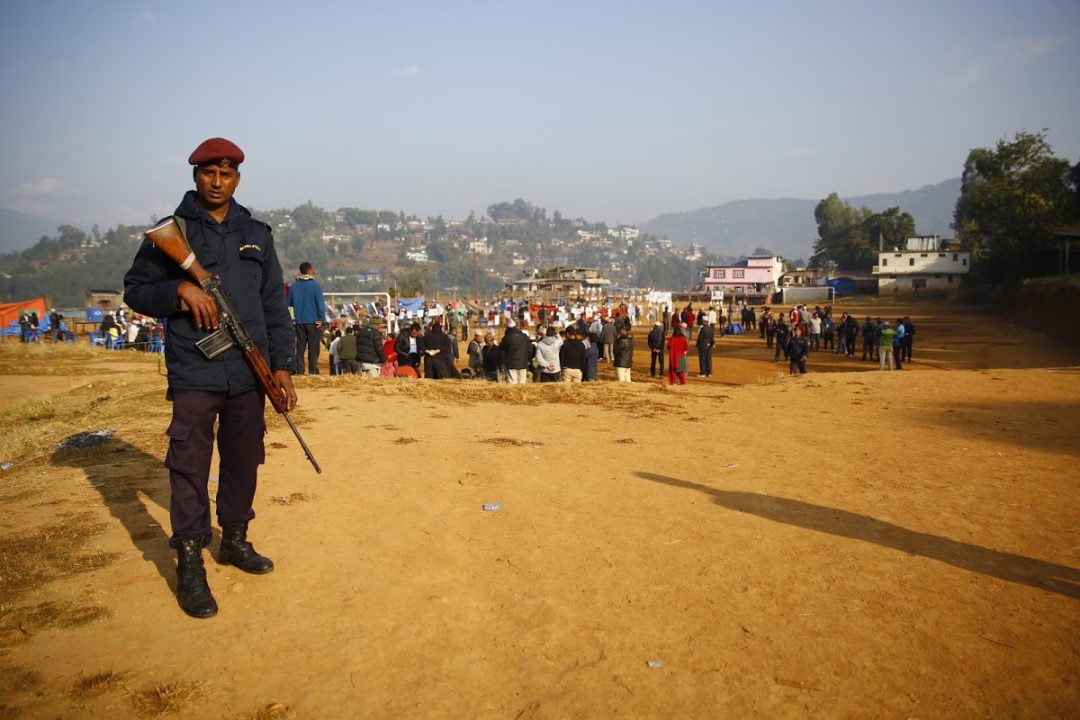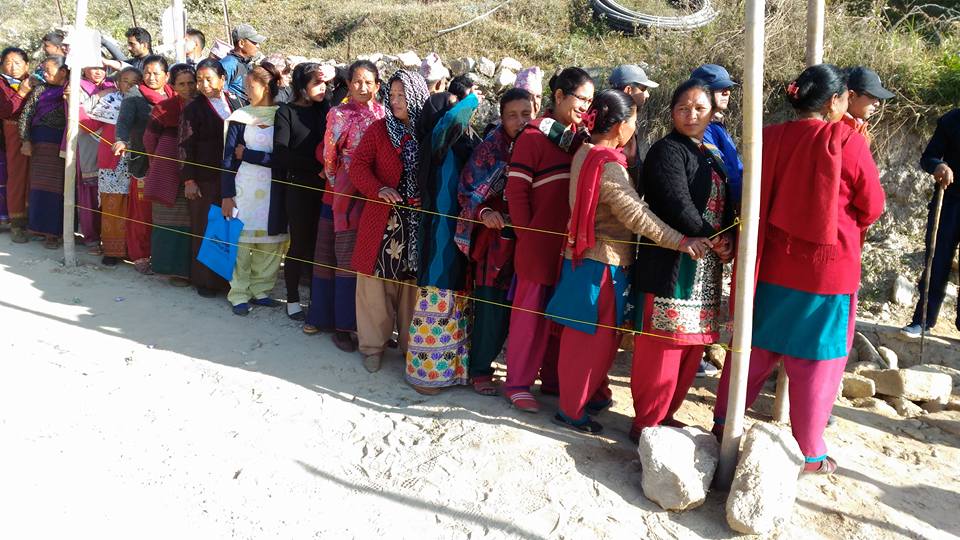November 29, 2017
Millions of Nepalis on Sunday cast their votes in the first of two-phase provincial and federal elections which will conclude on December 7. Thousands of candidates from more than 90 parties are competing for 275 seats in the new federal parliament and 550 seats in seven provincial assemblies across the country.

A police personnel guards a polling station area in eastern Nepal some 600 km from Kathmandu during the first phase of parliamentary and provincial elections on Nov. 26. Photo/Mr. Skanda Gautam, The Himalayan Times
Despite sporadic disruptions at election rallies and around election candidates, the overriding hope is that these elections—the first under the new constitution—will move Nepal out of an elongated post-conflict transition into a period of stabilization. For this to happen, all parties to the elections must remain committed to the completion of these electoral stages, which are essential to the realization of a more stable, democratic Nepal.
These elections come after the country’s first successful local elections that concluded in September 2017, in which Nepalis elected over 35,000 representatives to run 753 local governments. The majority of these newly elected representatives do not have previous experience in government. Much has been made of their lack of preparation, knowledge, and capacity. The commentary on local government incapability has been witheringly dismissive, contemptuous even. There is a collective failure to respect the people’s choice to vote in overwhelming numbers in the hope for change in the status quo of impunity in Nepali governance.

Party candidates posters are displayed on a wall ahead of legislative elections in Janakpur. Photo/Mr. Skanda Gautam, The Himalayan Times
Many have backgrounds in the private sector, including as real estate agents, contractors, and middlemen with known track records of voraciously serving their own private interests and their patrons in political parties. How they will govern in the public interest should be of greater concern than their background.
Thanks to new quotas for women candidates, and Dalit women in particular, local elections changed overnight the numerical representation of women in government, from previous handfuls to over 14,000 elected representatives now. However, the challenges of leadership are manifold: not only must these newly elected women be accepted, they are also expected to perform at par or better than their male counterparts, even though they have rarely been given the opportunity to exercise formal leadership.

Voters line up to cast their ballot. Photo/ANFREL
Fortunately, as women, and with previous experience in mediation, social mobilization, healthcare, and community action, they come more prepared than their male peers to the representational task. It is apparent that political parties have done the minimum necessary, and grudgingly, to meet constitutional requirements for inclusion. Sadly, a casualty of these electoral maneuvers is the further marginalization of Dalit men in local government.
At a glance, implementation of the 2015 constitution appears to be on track, and all three governments envisaged ought to be in place on schedule by January 2018. A closer look, however, is warranted at what appears to be unfolding. Depending on who has the vantage point, shared and self-rule through federalism is either a historic opportunity for Nepalis—albeit with problems that need to be collaboratively resolved—or a misinformed excursion by upstarts that needs to be curbed and whipped into shape before the country falls apart. We seem to be witnessing a struggle between those who believe authority derives from another government and those who would rather use the covenant of a codified and written constitution.
More than the need to address credibility and capacity issues of elected local government officials, the need to address this troubling behavioral dimension transcends technical fixes and is nontrivial. It is disheartening, for example, to witness functionaries of a previously centralized, unitary state fighting to preserve as much of the status quo as possible. Even a cursory examination of the directives, regulations, and acts mooted by government in recent months shows how difficult it is to transform a mindset oriented toward orchestrating governance and development from Kathmandu. Therefore, changing the hearts and minds of those who feel threatened, so that they accept and support constitutional provisions for shared and self-rule, is likely to be a costly effort that should be anticipated.
Chances are high that these provincial and federal elections will return even fewer positive results for marginalized populations and favor those with privilege, deep pockets, and narrow self-interest. Importantly, however, constitutional provisions for local government provide reassurance that the power and resources needed to address local interests and needs are now, more than ever, within reach if opportunity is seized. It is now conceivable that newly elected leaders in provinces and municipalities can address previously intractable development problems in a more effective manner. Each provincial and municipal government must find its own constitutionally empowered way to raise revenues and address needs. In many ways, the arena of accountability has shifted much closer to home, and those in new leadership can no longer pass the buck to Kathmandu.
With the completion of these elections, Nepal will have embarked on a new political course. By early 2018, one federal government, seven provincial governments, and 753 municipal governments will be in place with co-equal standing under the constitution. The anxieties of those who stand to lose power and the eagerness of those with newfound power must be tempered by the existential challenges that lie immediately ahead of this new republic. First, newly elected leadership will have to focus on accommodating these three nested power centers and their distinct preferences, needs, and interests. Working out the jurisdiction, authority, and resources for each one will require time as well as a nuanced approach—deploying peaceful negotiation, dignified compromise, and lawful challenge in court.
At this time, it is also important to maintain perspective and situate elections in the larger agenda of governance reform in Nepal. We must take fresh account of both the distribution of power and the tension between institutions of representation and institutions of restraint in conditioning state and non-state actions toward more accountability, transparency, and justice. Absent this accounting, the impunity of the past several years will remain entrenched and become distributed across Nepali society. Therefore, the tortuous transition toward democratic consolidation in a federal structure and the building up of new institutions must be understood as deep deficits that need to be addressed in both politics as well as the rule of law. Much remains to be done; let us embrace the task.
This is an edited version of an article first published by Nepali Times.
George Varughese is The Asia Foundation’s country representative in Nepal. The views and opinions expressed here are those of the author and not those of The Asia Foundation or its funders.
